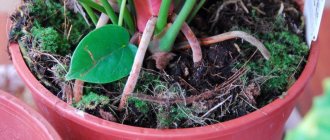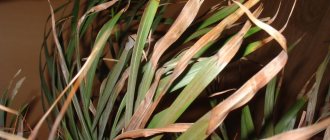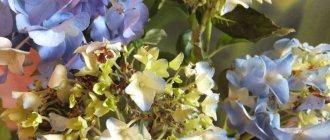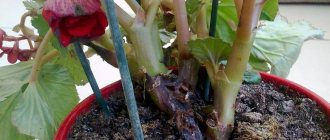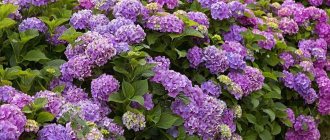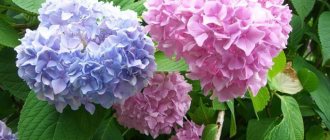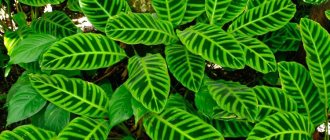Causes of disease and pests
The reason why a flower begins to hurt or is affected by pests is that it is kept in unfavorable conditions. Errors in care weaken the monstera; it does not receive important substances or, on the contrary, takes them in excess.
Important! Sometimes owners lose sight of the fact that in winter (from late autumn to early spring) watering needs to be significantly reduced and they continue to give the plant the summer amount of water.
Diseases can be caused by a lack of water, the wrong location, too little or too much sun, unsuitable temperature or humidity. Pests may settle on the plant. Especially if outdoor contaminated soil was used for replanting.
Why do dollar tree leaves turn yellow?
The main reason for yellowing foliage is a metabolic failure. This happens because the plant lacks light, moisture, nutrients, and so on. This is why the leaves of Zamioculcas turn yellow - it sheds them as ballast. This reduces the consumption of moisture and nutrients, and the plant has a chance to save younger shoots or at least the rhizome.
Healthy dollar tree leaves are dark green, glossy and succulent.
Note! In any case, the main reason for yellowing of the leaves will be improper care. Even the occurrence of plant diseases or the appearance of pests on it is the result of unsuitable conditions
How to save a flower if it dies
Before saving zamioculcas, it is important to find out what exactly caused the flower to behave this way. After all, by applying rescue measures at random, you can completely ruin the plant
To do this, you need to watch it for some time and find out what exactly your home phytofriend lacks. In the future, proper care should be restored and maintained.
Symptoms of monstera disease
Obvious symptoms of plant diseases are yellow or darkened leaves, the appearance of spots on them, drying out of the edges and their curling. Pay attention to the following signs:
- pale color and round holes - direct sunlight hits the plant and burns it, move the pot to partial shade;
- pale color – there are not enough microelements, the flower needs to be fertilized with a special fertilizer;
- rotting - excess moisture or too low air temperature, limit watering and place the monstera in a warmer place.
We will consider other symptoms and what to do if they are detected below.
Did you know? In the subtropics, monstera is grown for food purposes. When the fruits turn light green with open scales, they are harvested. This type is called delicacy.
The leaves are turning yellow
This phenomenon often indicates waterlogging of the soil in which the flower is contained. Monstera should not be watered during this period until it is completely restored, and then reduce the amount of water or frequency of watering.
If, in addition to yellowing, the leaves fall off en masse, it means that the humidity in the room is too low and the temperature is too high. In the summer, the monstera needs to be periodically sprayed with water, and in extreme heat, place a container with cold water next to the pot. The cause may be fusarium disease, chlorosis, as well as pests.
Leaves turn black (darken)
There are several reasons for this:
- scale parasites - destroyed with special means purchased at a flower shop, the flower is washed with water;
- unbalanced watering - if there is little water, the leaves are first yellow and then darken, and if there is a lot, blackness appears on the greenery immediately; rot can be wet or dry;
- anthracnose disease.
Dry around the edges
If your monstera leaves are drying around the edges, this may be due to:
- the air is too dry - you need to spray the plant;
- cramped pot - the roots of the flower should be freely placed in the soil;
- overmoistening of the soil - the leaves turn yellow, and the tips of the leaves begin to dry;
- draft and location under air conditioning.
Find out if you can keep an indoor monstera flower at home.
Curl up
Curling means the plant is too hot. Don’t be surprised if this happens in winter - at this time the flower is in a state of hibernation and should be in a room where the air temperature ranges from +15 °C to +20 °C.
Appearance of spots
Brown marks on the leaves indicate a draft and that the plant is cold. Move the monstera pot to another place or move it to a warmer room. The spots may become putrid if the flower receives too much moisture. In this case, the color of the lesion is darker.
Plant treatment
The origin of monstera is the tropical forests of Brazil, Central and South America. Today it is an exotic-looking indoor evergreen flower that has minimal care requirements and grows up to 4 meters in 5 or 6 years.
If a pest is detected, you must try to get rid of it using folk remedies (infusions of onion peels, tobacco or calendula, crushed garlic, a solution of tar or laundry soap). They are less radical and harmful both to the flower itself and to the people living in the apartment. The measure is justified when there are few insects and the plant has not had time to suffer much. Otherwise, it is better to use synthetic insecticides.
Timely treatment will help preserve Monstera
In order for the Monstera to please the owner with its appearance, it is necessary to establish proper care. First of all, it is removed from the draft and protected from accidental damage. You need to carefully select new soil for replanting the vine. The wrong composition is detrimental to the flower. The plant requires regular feeding and watering, diffuse lighting and spraying of leaves.
Common problems when growing Monstera
An unpretentious plant is rarely affected by diseases if it is given proper care and watering rules are followed. The same applies to pest settlements - they do not come to places where good conditions are not created for them.
Important! Monstera grows well in a permanent place. She is tolerant of shady environments, but loves space and fresh air.
Diseases and their treatment at home
Diseases to which monstera is susceptible:
- Fusarium is a fungal infection in the soil that loves moisture. When damaged, the roots of the flower rot, the stem becomes thinner, and the leaves turn yellow. There is no treatment, the monstera will die.
- Late blight is a fungus that causes root and stem rotting. Infection occurs through water, soil and equipment. A sign of the disease is brown-purple marks with a pale green area around, as well as a white coating on the bottom of the leaves. There is no effective treatment.
- Chlorosis - the leaves turn yellow, the leaf blade gradually becomes transparent, which also happens when the monstera stays in the light for a long time (try moving it to partial shade and observing). Iron chelate is suitable for treatment in the dosage indicated on the instructions (the product is sold in flower shops).
- Anthracnose - bright yellow spots appear with concentrated black or dark brown rings around them. For treatment, remove all affected leaves and stems, treat the plant with copper sulfate or Oxychom once every one and a half to three weeks. Repeat three times. Treatment is pointless if the entire flower is affected.
- Gray rot is the appearance of gray spots on the plant and tissue death. The disease is contagious to other flowers, so during treatment, quarantine the monstera and use your choice of Alirin-B, Fitosporin, Trichodermin, Gamair P.
Do not delay treatment so as not to lose the flower.
Pest extermination
Among the common pests that cause harm to indoor plants:
- The ivy scale insect settles everywhere, the monstera becomes oppressed, looks unattractive, the leaves turn yellow and crumble, and a sooty fungus appears. To combat, leaves and stems are wiped with soapy water, the air temperature is reduced and the humidity is increased. Apply a 0.2% solution of rogor, cut off the overly affected parts.
- Spider mite - settles at the bottom of the leaves and weaves a web on them, drinks the sap of the plant, causing it to wither and dry out. During treatment, regularly ventilate the room, increase air humidity, and treat the monstera with Actellik (15 drops per liter of water).
- Aphids - as signs of curvature of the tops, a sticky substance on the leaves, the appearance of black mushrooms. Pests are spreading rapidly. An effective remedy is mustard powder, poured with boiling water and infused (20 g per liter), sprayed over the entire monstera. A decoction of onion and garlic peels is also good.
- Thrips - appears at elevated ambient temperatures if the humidity drops overnight. It lives under the leaves, with light dots and a silvery sheen appearing on top of them. Insecticides are used for treatment.
- Mealybugs - their favorite place is young shoots, which due to parasites become deformed, dry out and fall off. The flower is dying. Treatment with Actellik (15 drops per liter of water).
Inspect your monstera regularly to respond to an infection in time.
Prevention and care measures
To prevent diseases and pest infestations, follow the following rules:
- buy plants in a specialized store - the likelihood of purchasing a diseased monstera is much lower, and you can get advice on care from a specialist;
- observe quarantine for new flowers for at least a week, only after that place the pots next to others;
- periodically wash the leaves with Epin or Zircon;
- From time to time, disinfect the soil with a weak solution of potassium permanganate and fertilize the soil;
- Provide good care to the plant in accordance with its requirements.
Did you know? If you keep the monstera in a dark room and do not feed it with fertilizers, the new leaves on it will be in the form of a solid plate.
Inspect your flower every week to spot any signs of problems as early as possible. The unpretentious monstera has a strong immune system if it receives enough minerals, water and light. Follow simple rules for caring for it and do not forget that they are different in summer and winter.
Brown spots on anthurium leaves: why they appear and how to get rid of them
A plant called anthurium is known to almost all gardeners. Due to the beautiful combination of green leaves and red flowers of the original shape, it is often called the flamingo flower. This is one of my favorite "pets" that does not require much care or attention. But recently I began to notice that brown spots began to appear on the plant's usually smooth and bright leaves.
I didn’t want to lose such beauty, and I immediately began to look for the cause of the problem, which I succeeded in quite quickly. If you had to face a similar situation, I will tell you how to save a flower from death and return it to its original appearance.

